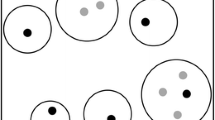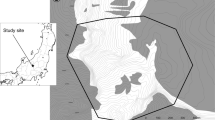Abstract
The study of intraspecific variation can provide insights into the evolution and maintenance of behavior. To evaluate the relative importance of ecological, demographic and social conditions thought to favor lekking, I studied variation in mating behavior among and within populations of the blackbuck, Antilope cervicapra, an Indian antelope. Rather than viewing lekking as a discrete mating strategy, I took a continuous approach and treated lekking as a question of the clustering of mating territories, with leks representing one extreme in a range of territory distributions. I surveyed nine blackbuck populations, which differed in population density and in habitat conditions. For each population, I described the mating system in terms of the clustering of mating territories, and measured various factors suggested to favor lekking. I found that large-scale, among-population variation in territory clustering was most strongly related to female group size. Territory clustering was not related to population density. Female group size, in turn, was best explained by habitat structure. Interestingly, these among-population patterns were repeated at a finer spatial scale within one intensively studied population. These findings suggest that territorial males respond to local patterns in female distribution (represented by group size) when making decisions regarding territory location. Finally, although female distribution may explain territory clustering at the population level and more locally within a population, other selective factors (e.g., female preference, male competition, male harassment) are likely to shape the clustering and size of territories at even finer scales.





Similar content being viewed by others
References
Almeida JB, Macedo RH (2001) Lek-like mating system of the monogamous blue-black grassquit. Auk 118:404–411
Anonymous (1999) Climatological tables of observatories in India, 1951–1980. Government of India
Anonymous (2002) Comparative climatic data for the United States [1971–2000]. Southern Regional Climate Center
Apollonio M (1989) Lekking in fallow deer—just a matter of density? Ethol Ecol Evol 1:291–294
Apollonio M, Festa-Bianchet M, Mari F, Mattioli S, Sarno B (1992) To lek or not to lek—mating strategies of male fallow deer. Behav Ecol 3:25–31
Balmford A (1990) Lekking in Uganda kob. PhD Thesis. University of Cambridge
Balmford A (1992) Social dispersion and lekking in Uganda kob. Behaviour 120:177–191
Balmford A, Albon S, Blakeman S (1992) Correlates of male mating success and female choice in a lek-breeding antelope. Behav Ecol 3:112–123
Balmford A, Deutsch JC, Nefdt RJC, Clutton-Brock TH (1993a) Testing hotspot models of lek evolution—data from 3 species of ungulates. Behav Ecol Sociobiol 33:57–65
Balmford A, Bartos L, Brotherton P, Herrmann H, Lancingerova J, Mika J, Zeeb U (1993b) When to stop lekking: density-related variation in the rutting behaviour of sika deer. J Zool 231:652–656
Bradbury J (1981) The evolution of leks. In: Alexander RD, Tinkle TW (eds) Natural selection and social behavior. Carron, New York, pp 138–169
Bradbury J, Gibson R, Tsai IM (1986) Hotspots and the dispersion of leks. Anim Behav 34:1694–1709
Bradbury JW, Gibson RM, McCarthy CE, Vehrencamp SL (1989) Dispersion of displaying male sage grouse.2. The role of female dispersion. Behav Ecol Sociobiol 24:15–24
Bro-Jørgensen J (2002) Overt female mate competition and preference for central males in a lekking antelope. Proc Natl Acad Sci USA 99:9290–9293
Bro-Jørgensen J (2003a) The significance of hotspots to lekking topi antelopes (Damaliscus lunatus). Behav Ecol Sociobiol 53:324–331
Bro-Jørgensen J (2003b) No peace for estrous topi cows on leks. Behav Ecol 14:521–525
Clutton-Brock TH (1989) Mammalian mating systems. Proc R Soc Lond B 236:339–372
Clutton-Brock TH, Guinness FE, Albon SD (1982) Red deer: behavior and ecology of two sexes. Edinburgh University Press, Edinburgh
Clutton-Brock TH, Green D, Hiraiwa-Hasegawa M, Albon SD (1988) Passing the buck—resource defense, lek breeding and mate choice in fallow deer. Behav Ecol Sociobiol 23:281–296
Clutton-Brock TH, Price OF, Maccoll ADC (1992) Mate retention, harassment, and the evolution of ungulate leks. Behav Ecol 3:234–242
Clutton-Brock TH, Deutsch JC, Nefdt RJC (1993) The evolution of ungulate leks. Anim Behav 46:1121–1138
Davies NB (1991) Mating systems. In: Krebs JR, Davies NB (eds) Behavioural ecology, 3rd edn. Blackwell, Oxford
Deutsch JC (1994) Lekking by default—female habitat preferences and male strategies in Uganda kob. J Anim Ecol 63:101–115
Gibson RM, Taylor CE, Jefferson DR (1990) Lek formation by female choice: a simulation study. Behav Ecol 1:36–42
Gosling LM (1986) The evolution of the mating strategies in male antelopes. In: Rubenstein DI, Wrangham RW (eds) Ecological aspects of social evolution: birds and mammals. Princeton University Press, Princeton, pp 244–281
Gosling LM (1991) The alternative mating strategies of male topi, Damaliscus lunatus. Appl Anim Behav Sci 29:107–119
Gosling LM, Petrie M (1990) Lekking in topi—a consequence of satellite behavior by small males at hotspots. Anim Behav 40:272–287
Hjorth I (1970) Reproductive behaviour in Tetraonidae. Swed Wildl 7:190–596
Höglund J, Alatalo RV (1995) Leks. Princeton University Press, Princeton
Isvaran K (2003) The evolution of lekking: insights from a species with a flexible mating system. PhD Thesis, University of Florida, Gainesville
Isvaran K, Jhala Y (2000) Variation in lekking costs in blackbuck (Antilope cervicapra): relationship to lek-territory location and female mating patterns. Behaviour 137:547–563
Isvaran K, St. Mary CM (2003) When should males lek? Insights from a dynamic state variable model. Behav Ecol 14:876–886
Jarman PJ (1982) Prospects for interspecific comparison in sociobiology. In: King’s College Sociobiology group (eds) Current problems in sociobiology. Cambridge University Press, Cambridge, pp 323–342
Jhala YV (1997) Seasonal effects on the nutritional ecology of blackbuck Antelope cervicapra. J Appl Ecol 34:1348–1358
Jiguet F, Arroyo B, Bretagnolle V (2000) Lek mating systems: a case study in the little bustard Tetrax tetrax. Behav Proc 51:63–82
Koivisto I (1965) Behavior of the black grouse, Lyrurus tetrix, during spring display. Finn Game Res 26:1–60
Langbein J, Thirgood SJ (1989) Variation in mating systems of fallow deer (Dama dama) in relation to ecology. Ethology 83:195–214
Lewis RA (1985) Do blue grouse form leks? Auk 102:180–184
Lingle S (2001) Anti-predator strategies and grouping patterns in white-tailed deer and mule deer. Ethology 107:295–314
Maher CR (2000) Quantitative variation in ecological and hormonal variables correlates with spatial organization of pronghorn (Antilocapra americana) males. Behav Ecol Sociobiol 47:327–338
Mungall EC (1978) The Indian blackbuck antelope: a Texas view. Kleberg Studies in Natural Resources, College Station
Mungall EC (1998) Bucks in the black: India vs. Texas. Exotic Wildl 8:1–3
Nefdt RJC (1995) Disruption of matings, harassment and lek-breeding in Kafue lechwe antelope. Anim Behav 49:219–429
Nefdt RJC, Thirgood SJ (1997) Lekking, resource defense, and harassment in two subspecies of lechwe antelope. Behav Ecol 8:1–9
Pinheiro JC, Bates DM (2000) Mixed-effects models in S and S-PLUS. Statistics and Computing Series, Springer, Berlin Heidelberg New York
Prasad NLNS (1983) Home range size of blackbuck, Antilope cervicapra, at Mudmal. Z Saeugetierkd 48:109–117
Prasad NLNS (1989) Territoriality in the Indian blackbuck, Antilope cervicapra (Linnaeus). J Bombay Nat Hist Soc 86:187–193
Ranjitsinh MK (1989) The Indian blackbuck. Natraj, Dehradun
Sokal RR, Rohlf FJ (1995) Biometry: The principles and practice of statistics in biological research. Freeman, Oxford
Stillman RA, Clutton-Brock TH, Sutherland WJ (1993) Black-holes, mate retention, and the evolution of ungulate leks. Behav Ecol 4:1–6
Stillman RA, Deutsch JC, Clutton-Brock TH, Sutherland WJ (1996) Black hole models of ungulate lek size and distribution. Anim Behav 52:891–902
Sutherland WJ (1996) Mammals. In: Sutherland WJ (ed) Ecological census techniques: a handbook. Cambridge University Press, Cambridge, pp 260–278
Thirgood SJ, Robertson A, Jarvis AM, Belbin SV, Robertson D, Nefdt RJ, Kamweneshe B (1992) Mating system and ecology of black lechwe (Kobus, Bovidae) in Zambia. J Zool 228:155–172
Thirgood S, Langbein J, Putman RJ (1999) Intraspecific variation in ungulate mating strategies: the case of the flexible fallow deer. Adv Stud Behav 28:333–361
Wegge P, Rolstad J (1986) Size and spacing of capercaillie leks in relation to social behavior and habitat. Behav Ecol Sociobiol 19:401–408
Wiley RH (1974) Evolution of social organization and life-history patterns among grouse. Q Rev Biol 49:201–227
Acknowledgements
I am very grateful to J. Brockmann, C. St. Mary, Y.V. Jhala, C. Chapman, M. Sunquist, J. Eisenberg, B. Bolker, and S. Quader for useful discussions and valuable comments on previous versions of the manuscript; the University of Florida, the Animal Behavior Society, the American Society for Mammalogists, and Sigma Xi for research funds; the Forest Departments of Andhra Pradesh, Gujarat, Maharashtra, Rajasthan, and Tamil Nadu in India for considerable logistical support and kind permission to work in various protected areas; Y.V. Jhala, the USFWS funded project titled Conservation of the Indian Wolf, and the Wildlife Institute of India for immense logistical help; K.V.R. Priyadarshini and B. Jethva for useful discussions and help in the field; E. Mungall, W. Kyle and J. Kyle for extensive support and help with the Texas population; and T. Czeschlik and three anonymous reviewers for constructive comments on the manuscript. This work complies with the current laws of the countries in which the work was carried out.
Author information
Authors and Affiliations
Corresponding author
Additional information
Communicated by T. Czeschlik
Electronic Supplementary Material
Appendix
Appendix
Table 4 is the Electronic Appendix, S1, and gives estimates (mean±SE) of territory clustering and ecological, demographic and social variables in nine blackbuck populations.
Rights and permissions
About this article
Cite this article
Isvaran, K. Female grouping best predicts lekking in blackbuck (Antilope cervicapra). Behav Ecol Sociobiol 57, 283–294 (2005). https://doi.org/10.1007/s00265-004-0844-z
Received:
Revised:
Accepted:
Published:
Issue Date:
DOI: https://doi.org/10.1007/s00265-004-0844-z




